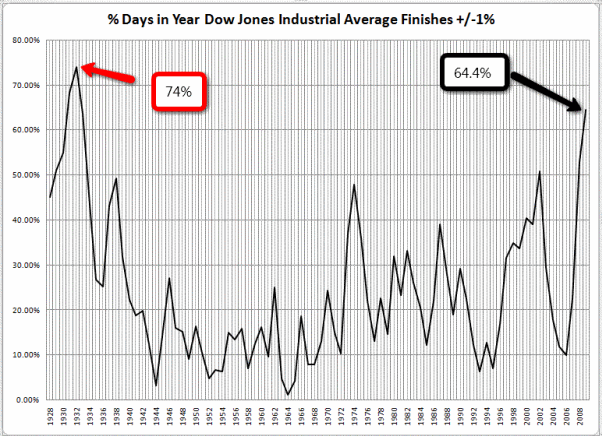| Current Volatility Rivaling The 1930s |
| By Price Headley |
Published
03/30/2009
|
Currency , Futures , Options , Stocks
|
Unrated
|
|
|
|
Current Volatility Rivaling The 1930s
If you are a long premium options trader, volatility is a necessary element to be successful. If volatility is lacking, time decay (Theta) will make this financial instrument a challenging one. These days, volatility is not lacking. In fact, volatility is thriving. For a long premium options trader, there is nothing like having market tailwinds to benefit your options strategy.
With a market that has gained 20% since March 9 bottoms, 2009 has obviously been an extremely volatile year thus far. This year seems to be even more volatile than 2008, which by our calculations, was the highest level of consistent daily volatility in decades. In 2009, there have been a multitude of sessions that have seen stocks rally or fall by a significant percentage. It seems almost commonplace that the Dow Jones Industrial Average is up or down at least one percent.
Volatility can be defined in many ways. In this analysis, we look at volatility by the number of occurrences the Dow Jones Industrial Average rallied or declined by one percent or more on a closing basis in a trading day. More specifically, we looked at the absolute return for the Dow Jones Industrial Average for each day going back to 1928. We then calculated the number of occurrences that the Dow Jones Industrial Average finished up or down more than one percent in a given year.
Below is a graph of the percentage of days out of each year that saw a market move of one percent or more. Two items that stand out are (1) the increase in volatility has soared since 2006 (from 10% to 64%) and (2) the current level of volatility only rivals the early 1930's when volatility peaked at 74%.
DJIA Daily 1% Move Graph (data as of 3/9/2009)

In 2008, there were 134 occurrences out of 253 trading dates (52.96% of days) that saw the Dow Jones Industrial Average finish up or down by one percent. This compares to the 2004 to 2007 period, which had a four-year average of 15.61%. This translates to only about 40 days per year in that four-year stretch that saw the Dow Jones Industrial Average fall or rise by one percent or more.
2009 has picked up where 2008 has left off. Our analysis was through March 9, 2009, -- as of that date we were on pace for an astonishing rate of 64% of the time the DJIA moves 1% of more on a daily closing basis. If the volatility continues through the last nine months of the year, this would be the most consistently volatile market since 1932, when the Dow Jones Industrial Average was up or down by one percent 74% of the time. Since March 9, there has been no letup in this trend as roughly 10 of the 14 days (or 71%) are moving at this rate (as of the March 27 close). So the % pace for 2009 is actually a bit higher than the 64% utilized in the above chart.
For long premium options players, this kind volatility can be a blessing. Buying calls, puts, straddles, and strangles can be advantageous in this environment. For the "buy and hold" stock and mutual fund investor, this volatility can only be digested with a six-pack of Dramamine and Pepto Bismol.
Another takeaway for long premium option players is that the level of volatility that we have seen will likely not last forever. Periods of high volatility will generally result in a lower one, as these periods tend to cycle in and out. This trend will likely go into a dormant stage with declining volatility and less price fluctuations.
Thus, having an arsenal of options strategies beyond long option premium will be even more important when the volatility wanes. Learning how to trade vertical credit spreads, iron condors, shorting straddles, shorting strangles, writing puts and covered calls will be important to add to one's repertoire.
Price Headley is the founder and chief analyst of BigTrends.com.
|